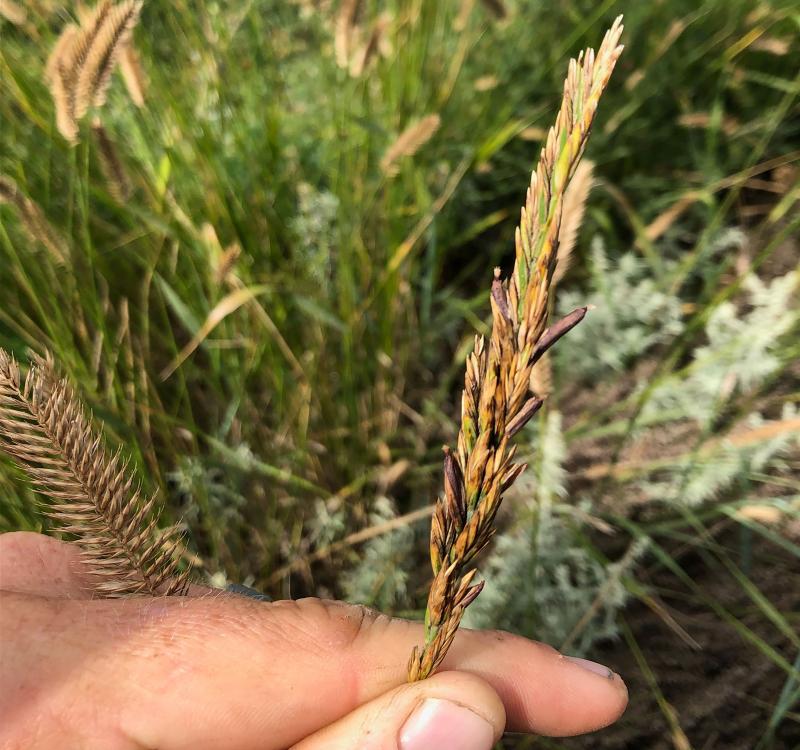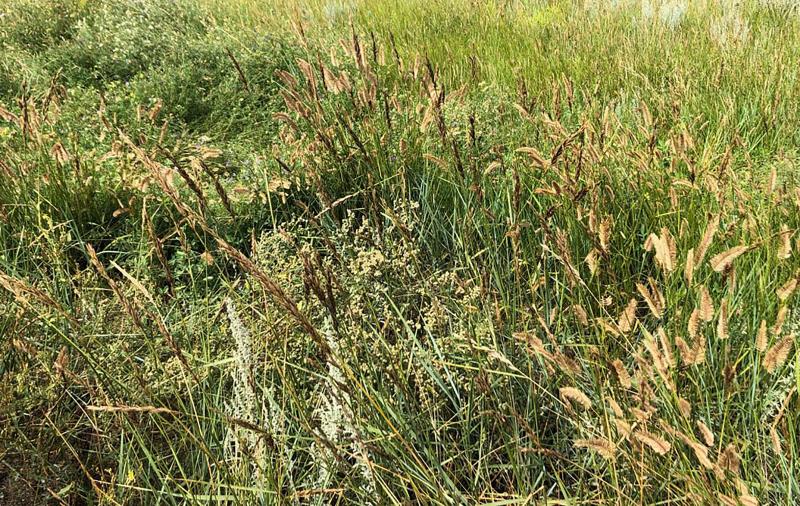
2019 has been a year fraught with challenges for ranchers across South Dakota. Abundant precipitation is usually a blessing, however, wet conditions coupled with a cool spring followed by warmer temperatures has caused another problem across the rangelands of South Dakota: ergot poisoning.
Ergot
Ergot is a fungus that grows on the seedhead of cereal grains and grasses. The fungus produces toxic compounds called ergot alkaloids which are vaso-active causing severe vasoconstriction of small arteries, leading to reduced blood flow especially in extremities (feet, tails, etc.). All animals are susceptible but cattle are often most affected. Vasoconstriction can also lead to poor thermoregulation and cause clinical signs of “summer slump” in animals (seeking shade, standing in water, decreased feed intake, lower weight gain and milk production)(Friskop et al., 2018). In the winter, reduced blood flow to the extremities can lead to frostbite. Further, reduced blood flow to the extremities can cause loss of hooves, tails and ears. Decreased fertility or abortion, and poor cattle performance can also result from ergot poisoning.
Examine Pastures

Western wheatgrass is a native cool-season, perennial sod forming grass with strong rhizomes. It is the most abundant grass in the South Dakota mixed prairie. Western wheatgrass has long been an important forage for winter grazing due to its ability to retain its forage value throughout the fall and winter. However, it is one of the grasses in the region that is most prone to ergot infection, although other grasses can also have it.
Ergot fungus is found on the seed head of the plant and is dark brown, purple or black (Figures 1 and 2). There are no practical ways to eliminate the ergot fungus from pastures and its toxicity does not disappear once temperatures drop below freezing. However, the ergot fungus is primarily affected by climatic conditions, so pastures are not persistently infected.
Grass in pastures or grass hay should be inspected to determine if the fungus is present. Ideally, due to the fungus being in the seedhead, grazing pastures before grasses develop a seed head would be advisable.
However, during winter grazing or dormant season grazing, most grasses have already developed a seedhead. Therefore, ranchers must be extremely diligent to determine if the fungus is present and to observe the health condition of their animals.
Grass Clipping Analysis
If a rancher suspects that ergot is present in winter grazing pastures extreme caution must be taken. According to Dr. Russ Daly, SDSU Extension Veterinarian: “Diagnosis of ergotism is usually made on the basis of clinical signs in the animal and presence of large numbers of ergot bodies in grain or on grass in the pasture. When it comes to the crude levels of ergot bodies in feed, it is difficult to establish a safe level due to variation in toxin levels and susceptibility in animals.”
Collecting grass clipping samples and testing for toxic levels of ergot alkaloids may also be advisable. For more information on how to obtain grass clipping samples please refer to SDSU Extension video “Mineral Content Sampling That Matches Pasture Grazing.” Total dietary levels of 100-200 ppb of ergot alkaloids in feedstuffs can be associated with adverse effects on livestock performance, but this is dependent on many animal and environmental factors (Daly, 2013).
Recommendations
Removing animals from the source of the ergot toxins and providing supportive care is the only treatment for affected animals (Daly, 2013). If a pasture utilized for winter grazing is suspected to have ergot, the pasture needs inspected to determine if the fungus is present. Grass clippings can also be done to determine if toxic levels of ergot alkaloids are present.
If suspected pastures must be grazed; extremely diligent observation for clinical signs of ergot poisoning must be done. Diligent observation of what species of grasses the cattle are selectively grazing in the pasture may also be useful. Contact your veterinarian or extension expert with questions about ergot poisoning.
References:
- Daly, R. (2019, February 26). Ergot: A Potential Livestock Poisoning Problem.
- SDSU Extension, (2018, November 1). Mineral Content Sampling That Matches Pasture Grazing.
- North Dakota State University. Ergot in Small Grains.


